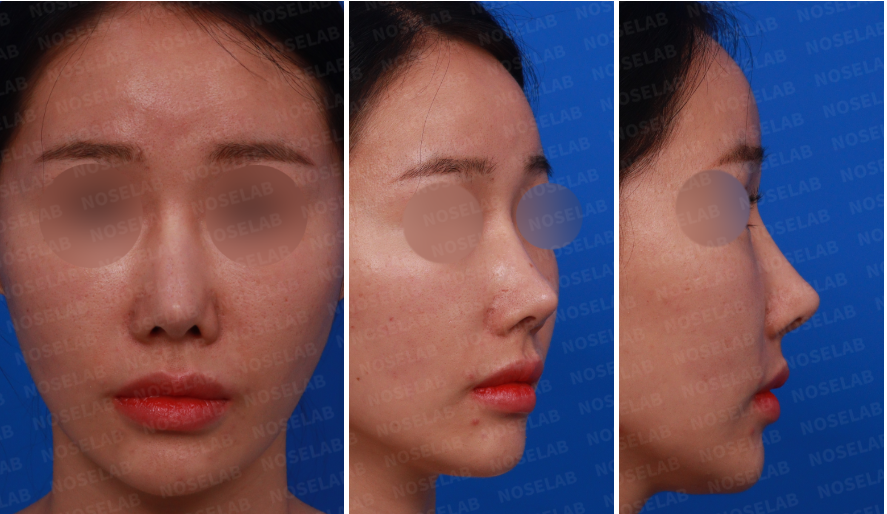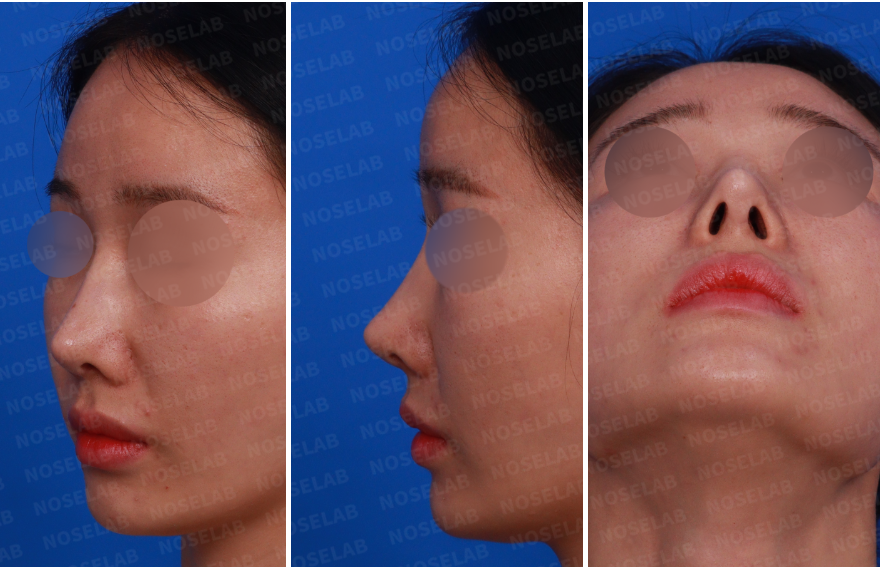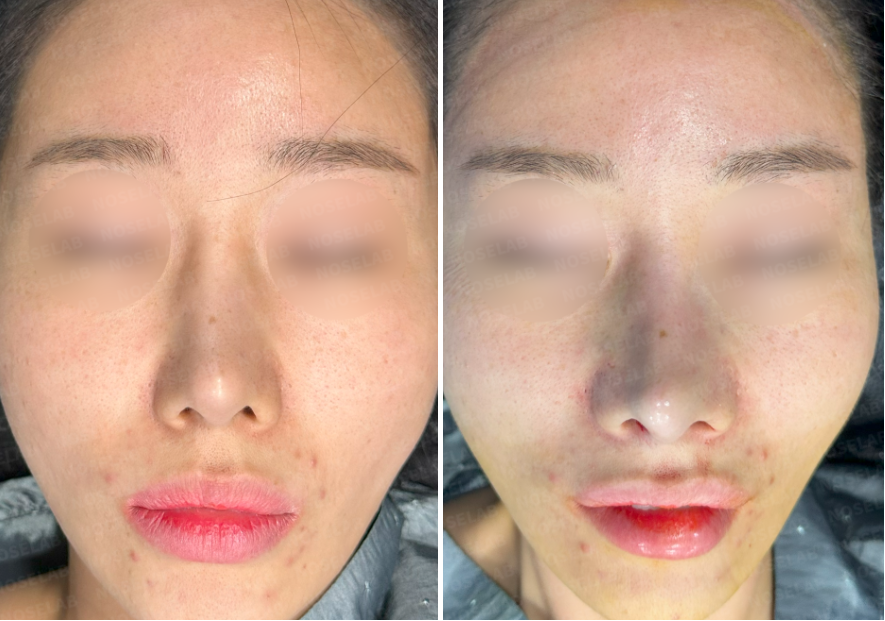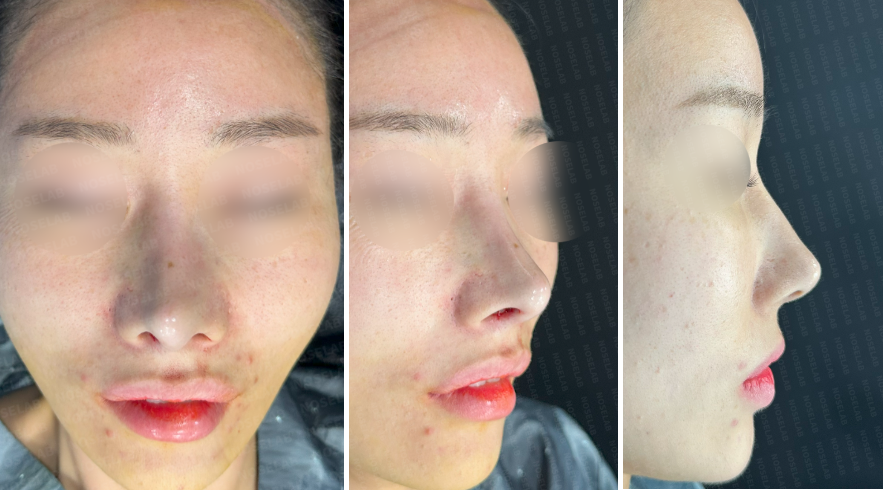Transforming a Pointy "Operated" Look into a Natural, Straight Nasal Line_Rhinoplasty Korea
- noselab
- 2024년 10월 25일
- 3분 분량
최종 수정일: 4월 7일
Hello, this is Dr. Cha-Young Kang, the chief surgeon at Nose Lab Clinic.
Today, I’d like to share a case where we transformed a noticeable, surgically altered nose into a more refined and natural appearance. This patient had previously undergone rhinoplasty in 2018 using ear cartilage and a silicone implant, and in 2021 received additional functional surgery for nasal obstruction along with a height increase using autologous rib cartilage and a silicone implant.
1. Pre-Surgery Consultation and Analysis
Patient’s Requests:
Satisfied with the current height.
Wanted to reduce the obvious “surgical” look of the nose.
Sought to improve nasal obstruction.
Analysis of Pre-Surgery Condition:
Frontal View:
The nasal bridge appeared crooked and wide.
Nostrils were asymmetric and overly exposed.
Oblique View:
The curved line of the nasal bridge was too pronounced, making the surgery noticeable.
The nasal tip was elevated, contributing to an artificial appearance.
Side View:
The nasal tip appeared too pointed.
The nasolabial angle (angle between the nose and upper lip) was over 90 degrees, making the nose look upturned.
The nasal bridge’s starting point was too high, emphasizing the surgical appearance.
Nostril View:
The right nostril appeared smaller.
The columella was slightly tilted to the left.
2. Surgical Plan
Based on the patient’s condition and requests, we developed the following surgical plan:
1) Septal deviation correction using autologous rib cartilage:
Improve nasal obstruction.
2) Septal extension graft:
Correct the upturned nose.
Improve nostril asymmetry.
3) Lateral osteotomy:
Straighten the crooked nasal bridge.
4) Septal reconstruction if necessary, depending on the severity of septal deviation observed during surgery.
3. Surgical Procedures
1) Harvesting autologous rib cartilage
2) Septal deviation correction and septal extension graft
3) Lateral osteotomy
4) Nasal tip refinement and nasolabial angle adjustment
4. Before and After Comparison
Before (Left) / After (Right)
Frontal View:
The previously crooked nasal bridge is now straightened.
Nostril asymmetry and excessive exposure have been corrected.
Before (Left) / After (Right)
Oblique View:
The overly curved, operated-looking line has been softened, creating a smooth, straight line.
The nasal tip appears more rounded and natural.
Before (Left) / After (Right)
Side View:
The overly elevated nasal tip has been brought down to a more natural position.
The nasolabial angle has been adjusted to approximately 95 degrees, reducing the upturned appearance.
The previously noticeable surgical look has significantly diminished.
Before (Left) / After (Right)
Nostril View:
The tilted columella has been corrected, and the nostrils are now more symmetric.
5. Immediate Post-Op Photos
Photos Immediately After Surgery: Frontal, Oblique Side, and Side Views
Photos Immediately After Surgery: Nostril View
6. Conclusion
This case exemplifies how we transformed a noticeably “surgical” nose into a more natural and sophisticated appearance. Several issues, such as the overly curved bridge, upturned nasal tip, and nostril asymmetry, were addressed simultaneously, while also improving nasal functionality through septal deviation correction.
7. Final Thoughts
The "surgical" look in rhinoplasty often arises when the nasal bridge is too high, causing the eyes to appear closer together, or when the nasal tip is too pointed. This often leads to what many refer to as an "operated" appearance. To avoid this, it is crucial to design a nose that looks natural and harmonious with the rest of the face.
A thoughtful and balanced design approach that considers the overall facial proportions is essential to achieving long-lasting, natural beauty. This case demonstrates the importance of focusing on both the aesthetic and functional aspects of rhinoplasty.
For those struggling with an overly surgical appearance, we hope this case offers some reassurance. At Nose Lab Clinic, we always prioritize natural and sophisticated results, tailoring each surgery to the unique facial features and needs of our patients.
If you’re considering rhinoplasty, we encourage you to consult with a specialist to find the most suitable and natural design for you. At Nose Lab Clinic, we’re committed to helping you achieve a beautiful and healthy nose.
This has been Dr. Cha-Young Kang, head surgeon at Nose Lab Clinic.
Thank you.












Comments